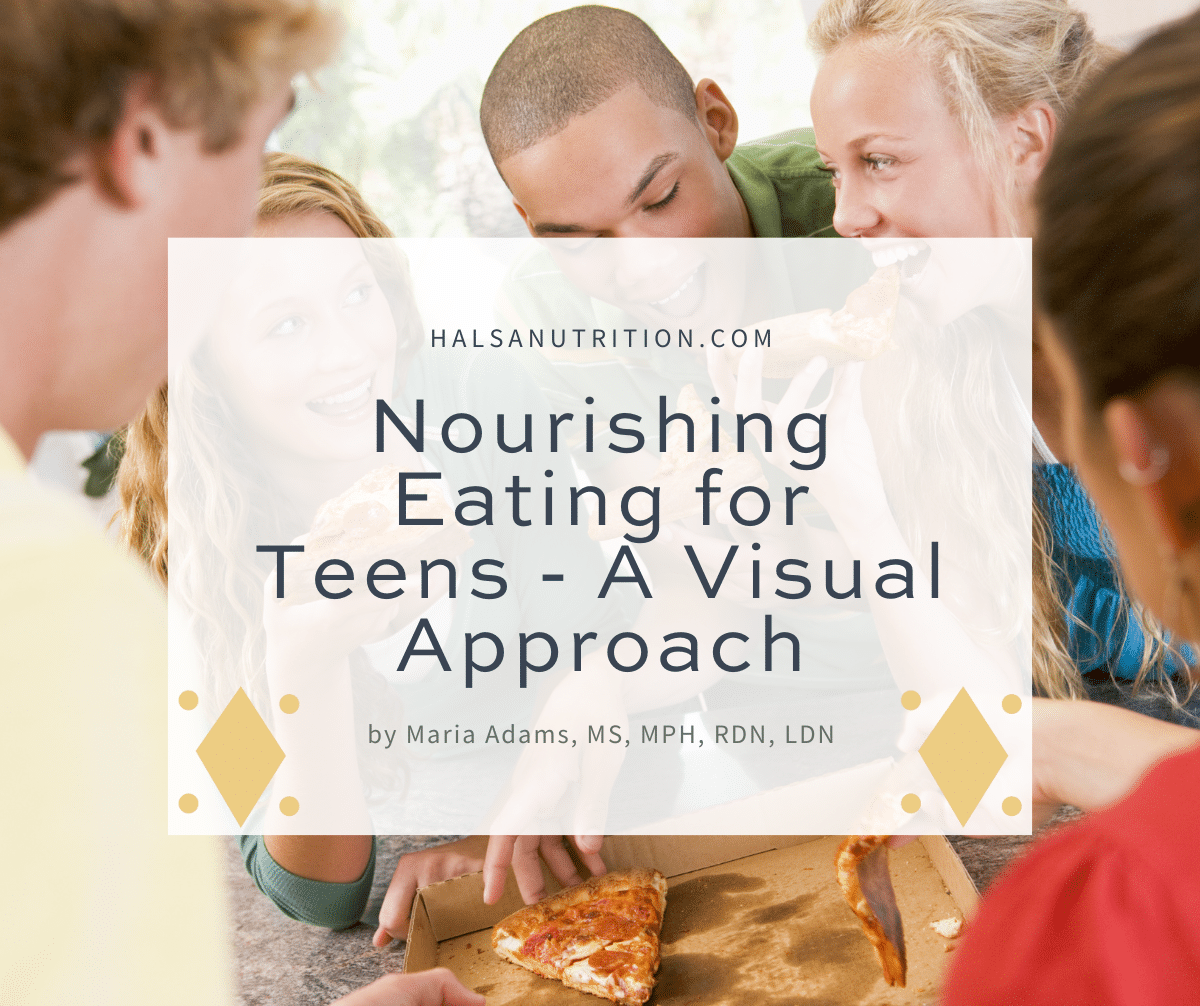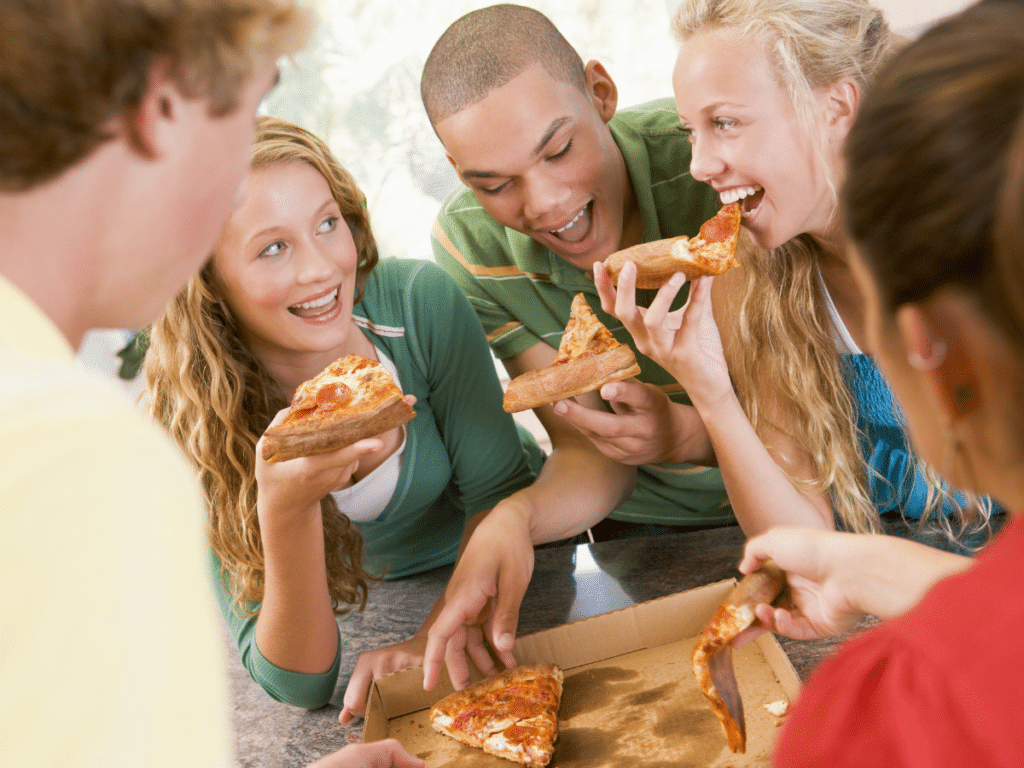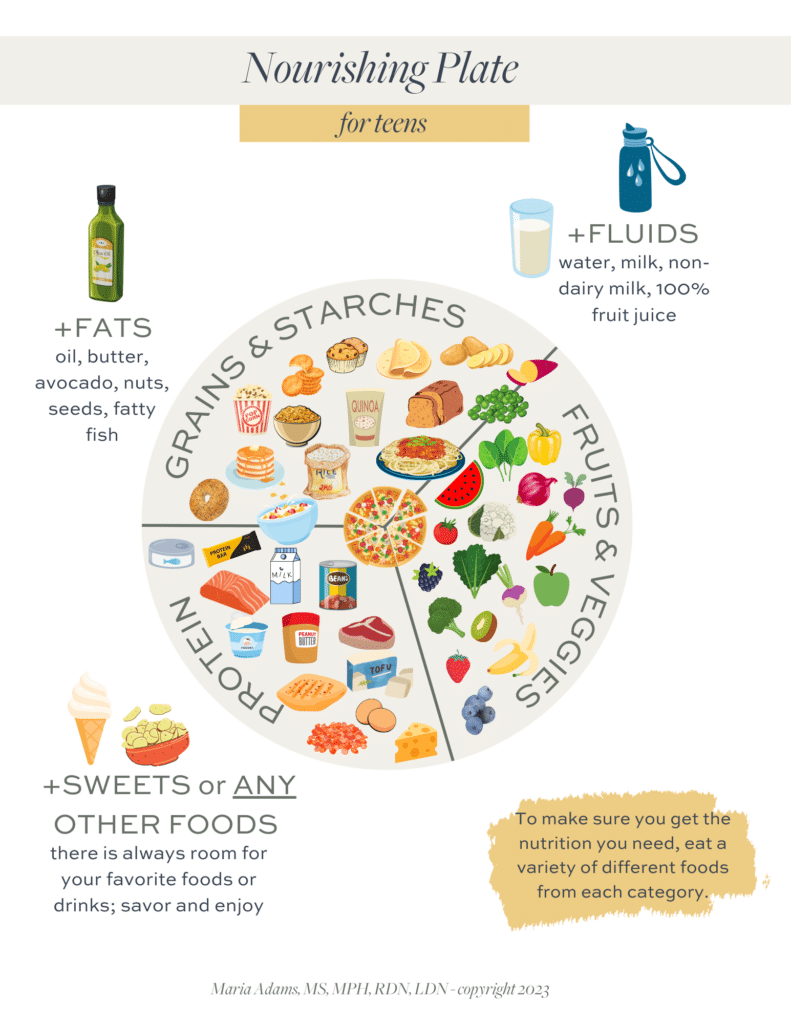
Nourished Eating for Teens – A Visual Approach
Estimated reading time: 7 minutes
Whether you are a parent or caregiver, there may be times when you wonder about what nourished eating for teens should look like. Or perhaps you are a teen who is interested in figuring this out yourself! Either way, this nourishing plate guide takes a non-diet, visual approach and simplifies the healthy eating question.
“Remember to eat your veggies.”
“Carbs are important for energy.”
“You need some protein on that plate.”
If any of these statements sound familiar, perhaps it’s because you have said something similar to your tween or teen. (Or, if you are a teen, perhaps your parent or coach has said something like this to you!)
The Challenges of Nourished Eating for Teens
Adolescence is a time of independence when kids are making their own breakfast and choosing their own lunch. They may still stick to the foods and routines engrained during early childhood, or they may decide to challenge the way they have grown up eating. They are also heavily influenced by peers and social media.
In addition, teens are busy and often feel they don’t have time for breakfast or morning snack time like they did in preschool. Of course, eating regular meals and snacks is just as important now as it was when they were four-year-olds. The adolescent years are a time of growth and kids who play sports need even more fuel.
What Nourished Eating for Teens Looks Like
So how should your teen eat? And what’s a simple way to remind them what a nourished plate looks like?
I like to use a plate approach when guiding tweens and teens on how to eat. It’s similar to the USDA’s My Plate, but in my opinion, it takes a simpler approach. It’s also free of diet culture and negative statements, such as “foods to avoid”, which are generally not helpful and can lead to disordered eating.
Establish a Regular Pattern of Eating
When working with adolescents, I first focus on helping them establish a regular eating pattern. For most tweens and teens this means eating Breakfast, Lunch, and Dinner plus 2-3 snacks. I emphasize that skipping meals is not helpful and can have detrimental effects, such as a lack of energy, getting over-hungry later, and reduced muscle strength.
Purchase a “Nourishing Plate Guide for Teens” on RD2RD.com. Thanks for your support!
Aim for Balanced Meals
Next, I emphasize having balanced meals, at least most of the time. What does a balanced meal look like? To keep it simple I suggest including the following 3 components on each plate:
1 – Grains and Starches
Grains and starches should make up about 1/3 of the plate for growing tweens and teens. For athletes with heavy training schedules and those recovering from an eating disorder, this group should make up a bigger component of the plate, about 1/2 the plate.
This category should include a mix of whole grains, refined grains, and starchy veggies. They all provide important nutrients, but here are some differences.
- Whole grains, such as oats, whole wheat bread, whole grain cereal, barley, farro, and quinoa are great for providing long-lasting energy and fiber.
- Refined grains such as white bread or white rice are great for providing quicker energy and are sometimes easier to digest before sports.
- Starchy veggies include potatoes, sweet potatoes, and corn. You could also put these in the veggie group, but their carbohydrate makeup is more similar to that of a grain.
2 – Fruits and Veggies
Fruits and veggies should make up about another 1/3 of the plate. Fruits and veggies are loaded with important vitamins and minerals. They also provide fiber, which is important for healthy digestion and overall health.
3 – Protein
Protein-rich foods should also make up about 1/3 of the plate. Protein is essential for growth as well as building and repairing muscle and other tissues. When you don’t get enough the body may break down its own muscle for protein.
Protein-rich foods include animal meats, eggs, dairy, soy, legumes (lentils, beans, and peanuts) tree nuts, and seeds.
Dairy or Non-Dairy Substitutes
For optimal nutrition, there should also be a dairy or non-dairy substitute included on this plate or on the side. Sometimes this may be the protein source, other times it may be an extra. Dairy is important because it’s a great source of calcium and vitamin D — nutrients that most teens fall short on.
Fat
There should also be a source of fat at each meal. Fat is an important source of omega-3 fatty acids which provide an array of health benefits. Fat also provides us with vitamin E and is essential in order for us to absorb the fat-soluble vitamins, which include vitamins A, D, E, and K.
Good sources of fat include oil, butter, avocado, nuts, seeds, and fatty fish. Animal meats, dairy products, and eggs also contribute to fat intake. The foods highest in omega-3s include fatty fish, eggs, walnuts, chia seeds, hemp hearts, flax meal, and canola oil.
“Combination Foods“
Many foods will provide a combination of these food groups. A classic example is pizza, which could provide every food group if you wanted. In fact, most recipes and meals provide at least two different food groups, which is great and makes getting a variety of nutrients on the plate easier!
Sweets, Salty Snacks, or Any Other Favorite Foods
There is a place for foods in the diet that don’t fit neatly into the above categories. It’s about looking at your whole pattern of eating. Yes, most of the food in your diet should be nutrient-rich. But it’s also important to include foods that are high in pleasure and satisfaction. Aim to find the balance and try to refrain from labeling foods as good/healthy or bad/unhealthy.

Most of the Time Mindset
Rather than aiming for perfection or a super healthy diet, have your teen adopt a “most of the time” mindset when it comes to food and nutrition guidelines. For example, they should aim to eat 3 meals and 2-3 snacks most of the time. And they should aim to have balanced meals that include a variety of nutrient-rich foods most of the time. This mindset takes away the rules and rigidity of diet culture and allows for flexibility and reality. It also makes them less likely to develop an eating disorder.
Non-Diet Mentality
Taking a non-diet, intuitive eating approach to eating takes away the negative effects of diet culture and helps us focus on what truly matters. This isn’t easy in today’s day and age, but it gets easier with practice. When I work with clients on improving their relationship with food, I like to use this intuitive eating plate model to help them guide their choices.
You and your teen should learn to call out diet culture when you see it–whether it’s the latest trendy eating plan or the word “skinny” or “guilt-free” on a label.
Social Media
Talk to your teen about social media and the importance of only getting nutrition information from trusted sources such as a Registered Dietitian. Believe it or not, anyone can call themselves a “nutritionist” or “nutrition expert” and there is a lot of misinformation out there. Social media can also have a negative impact on body image for children, teens, and even adults.
Eating Disorders
Eating disorders and disordered eating are at an all-time high among tweens and teens. If you are concerned about your child’s eating habits, relationship with food, or weight change, please reach out to your primary care doctor. You can also go to the National Alliance for Eating Disorders and call their hotline.
Bottom Line
Nourished eating for teens is about more than just the nutrition on your plate. It’s also about your relationship with food. Your teen should be eating enough food, eating consistently throughout the day, and have variety in their diet so that they get both the calories and nutrients that they need. But it’s important to remember that in addition to nutrition, food also contributes pleasure, joy, culture, and tradition.
Other Posts You Might Like
- Intuitive Eating for Teens
- How Much Protein Do Teens Need?
- 50+ Lunch Ideas for Teens (Printable Guide)
- Post-workout Snacks for Teens and Tweens
- Pre-Sport Snacks for Tweens and Teens
- Letting Go of the Diet Mentality
- An Intuitive Eating Plate and Other Plate Models
Sources and References
About the Author
Maria Adams, MS, MPH, RDN, LDN, a registered dietitian and Certified Intuitive Eating Counselor. Maria takes a weight-inclusive approach and helps individuals rediscover the joy of food by helping them heal from chronic dieting and disordered eating. She holds a Bachelor of Science Degree in Nutrition Science, a Master of Science in Nutrition Communication, and a Master of Public Health.

Leave a Reply